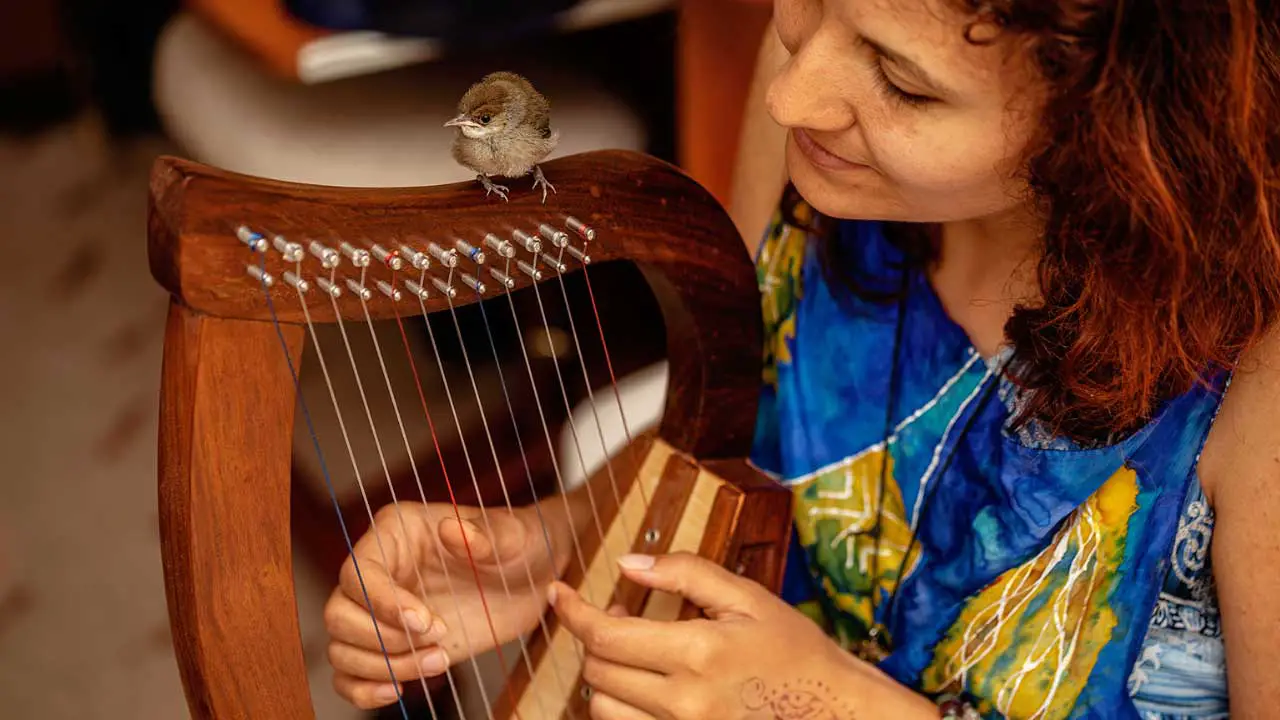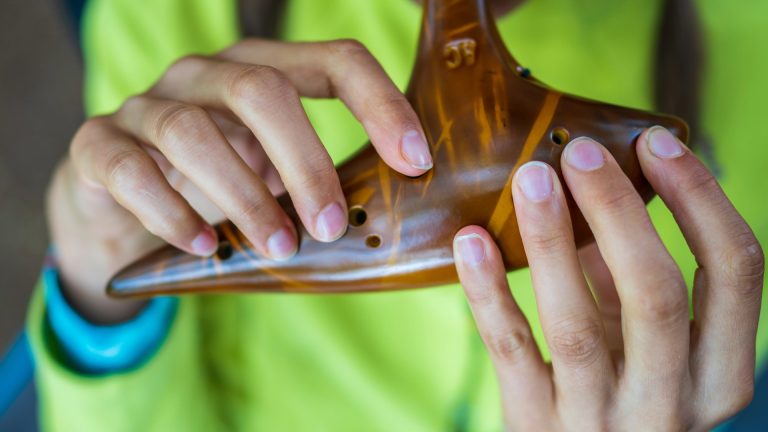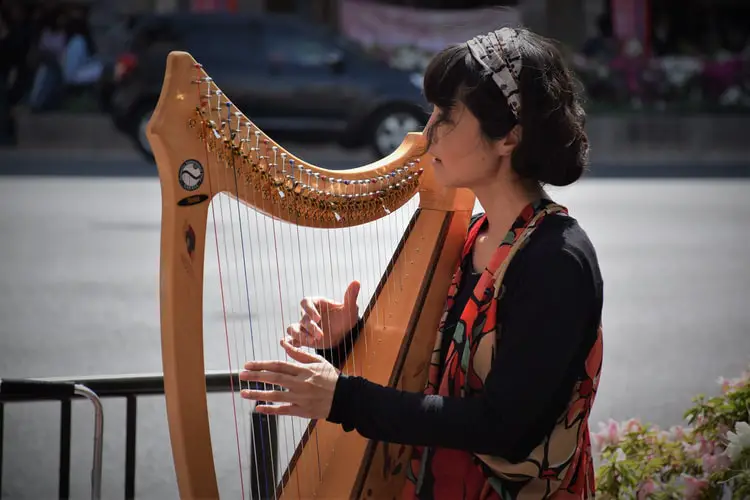Types of Small Harp: Exploring Compact and Portable Options
Folkstrings.com is reader-supported. When you buy through links on our site, we may earn a small commission.
I’ve always been fascinated by the delicate sounds of the harp, an instrument that boasts a rich historical and cultural lineage. Small harps, in particular, are a captivating family within the broader harp category, often praised for their portability and suitability for beginners.
These petite stringed instruments, commonly referred to as lap harps due to their size allowing them to be played on the player’s lap, come in various types each offering a unique charm and sound.
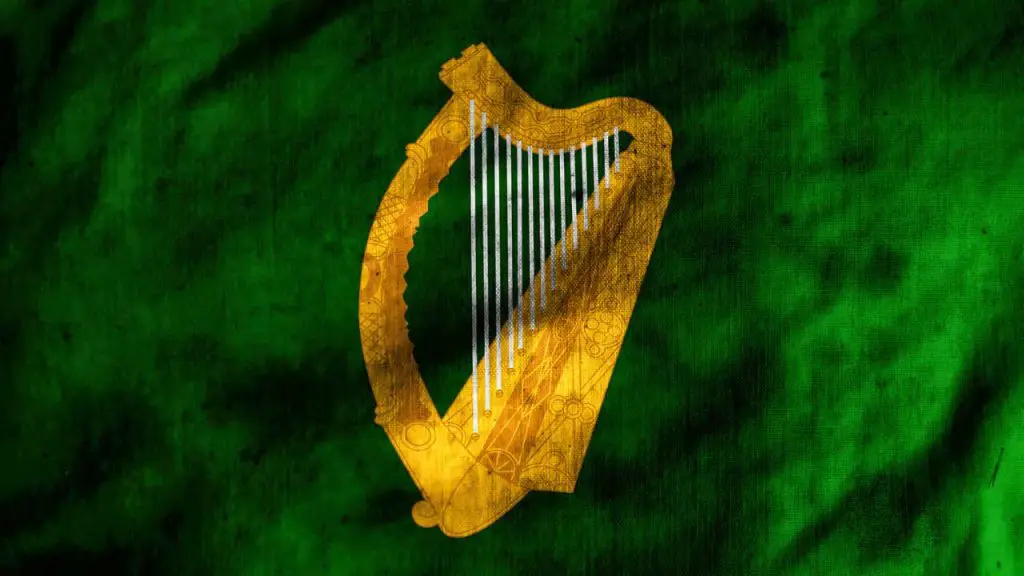
Exploring the realm of small harps, I’ve come to appreciate their diversity, from the traditional Irish harp with its deep connections to Celtic culture, to the more contemporary lever harps that feature levers at the top of the strings for quick key changes.
Whether you’re a novice seeking your first instrument or a seasoned musician looking to expand your repertoire, small harps offer an accessible and enjoyable entry point into the world of stringed instruments.
Key Points
- Small harps, also known as lap harps, are diverse and portable, making them ideal for beginners.
- The types of small harps include the historical Irish harp and the versatile lever harp.
- Their ease of learning and cultural significance make small harps a rewarding choice for musicians.
- The Donner 16-string lyre harp is crafted from solid mahogany and carbon steel keys, ensuring a clear and gentle sound.
- The package comes complete with the harp, spare string set, gig bag, tuning wrench, instruction book, polishing cloth, and 2 picks
- Tuning the harp is made easier thanks to the wrapped strings and the included tuning wrench and manual. You can even use a small hammer for fine-tuning.
- With 16 strings, spanning from G3 to A5 in the C major scale, this harp offers a wide range of tones, eliminating the need for frequent retuning.
- Its elegant design, made from high-quality Mahogany, makes it a great gift for beginners and kids.
What Are The Different Types of Small Harps?
In exploring the world of small harps, I’ve discovered a variety of types each with their own charm. These instruments are particularly beloved for their portability, and many are favored by traveling musicians for their compact size.
Lyre Harps
Lyre harps, with their gentle curves resembling the ancient Greek instrument, are plucked with the fingers and often have a warm, mellow tone. They typically feature strings that run parallel to the soundboard.
Celtic Harps
Celtic harps, known for their rich history and cultural significance, are characterized by their strong, resonant sound. These small harps may have nylon, gut, or wire strings and are frequently used in traditional folk music.
Lever Harps
Lever harps have levers at the top of each string to change pitch. They’re modern lever harps often chosen for their versatility and are a step between the simpler Celtic harps and the complex pedal harps.
Lap Harps
Lap harps are small enough to be placed on the player’s lap. They are favored for their ease of use and convenience, making them perfect for casual playing or when space is limited.
Wire Strung Harps
Wire strung harps, often seen in historical replications, have a distinct bell-like sound. Their wire strings can be made of metal such as bronze or brass, producing a bright, clear tone.
Electric Small Harps
Electric harps are equipped with pickups to connect to an amplifier, enabling them to be used in modern music settings. They blend the traditional harp sound with the ability to project in larger performance venues.
Other Varieties
There are also many other varieties of small harps such as the Aeolian harp, which is played by the wind, and the lyre harp, often called a mini harp. The names and types of small harps can vary widely, each suited to a different style or preference.
Buying Guide for Small Harps
When I embarked on my journey to buy a small harp, I focused on several key factors to ensure I made a wise purchase. My aim was to find an instrument that balanced cost with quality, especially suitable for a beginner like me.
Where to Buy a Harp
I searched for reputable dealers and harp makers online and visited local music stores. Buying from a well-known source gave me confidence in the authenticity and quality of the harp.
Scale and Price
An imperative aspect was the harp’s scale. Smaller harps often come in various sizes and the number of strings affects the scale and repertoire I can play.
Prices generally ranged from affordable for simple models to higher for those with intricate craftsmanship. I set my budget beforehand, which helped me narrow down my choices without getting overwhelmed.
- Lever Harps: Suitable for beginners and available at lower prices.
- Lap Harps: Even smaller and more affordable, but with limited range.
Weight and Transport
Considering the weight was crucial for me since I wanted to easily transport my harp.
Most small harps are light enough for comfortable transit, but I made sure to check the weight before buying. Some options I considered included:
- Harps under 10 pounds: Ideal for frequent travel.
- Weight range of 10-20 pounds: A good balance between portability and sound resonance.
Quality
I scoured for high-quality harps that promised durability and pleasing sound.
While professional harpists may invest in high-end models, I found there are many affordable harps that don’t compromise on sound quality. It’s important to check the materials used and read reviews from other harpists.
Is Harp a Good Beginner Instrument?
Choosing an instrument to start learning music can be a delightful yet challenging decision. I’ve found that the harp, with its soothing tones and elegant presence, is often considered an intriguing option for beginners.
Can You Self-Teach Harp?
In my experience, self-teaching harp is possible, especially if you have a strong sense of discipline and access to quality learning resources.
While self-teaching may come with a steep learning curve, the following points can help guide your journey:
- Starter Instrument: A smaller lap harp can be an ideal starting point due to its affordability and portability.
- Online Resources: There’s a wealth of tutorials and lessons available online that cater to harp beginners.
- Practice Schedule: Consistent and focused practice is key. Even 15-30 minutes a day can yield progress.
- Finger Placement: It’s crucial to begin with proper hand technique to avoid forming bad habits that are hard to break later on.
- Simple Repertoire: Start with simple songs. This helps you to gradually build up your skills and confidence.
Is Small Harp Easier to Learn than the Regular Sized Harp? My Experience
Learning on a smaller harp, such as a lever harp, can indeed be a bit more accessible than starting with a full-sized pedal harp. There are a few reasons why this might be the case:
- Size and Portability: Smaller harps are easier to handle, especially for beginners who might find the size and weight of a pedal harp intimidating. Their portability also makes it easier for you to find a comfortable place to practice.
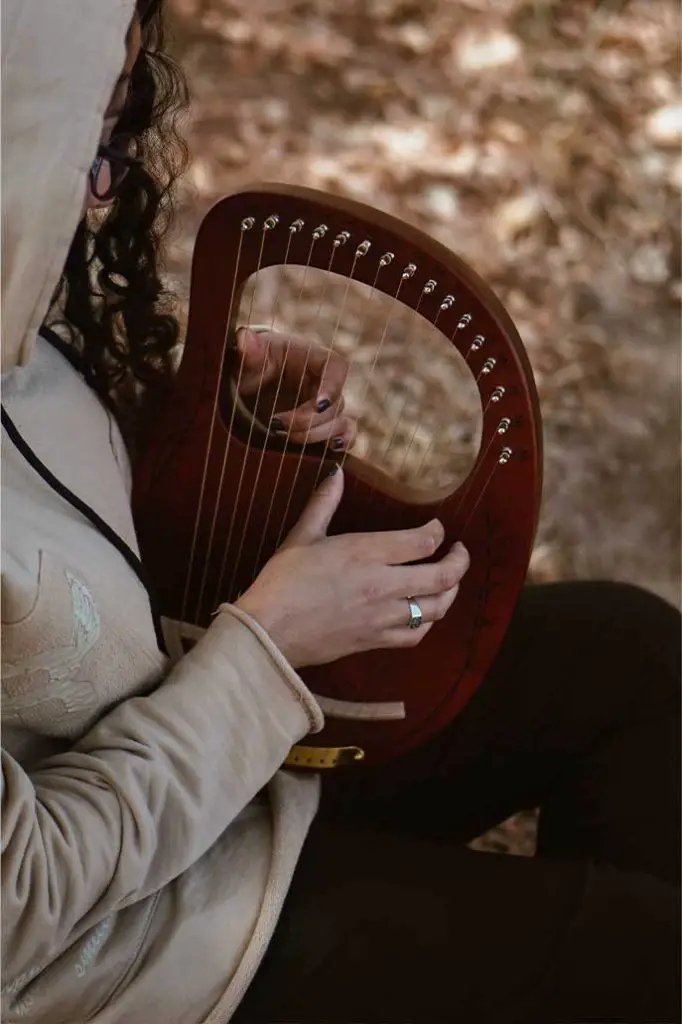
- Number of Strings: Smaller harps typically have fewer strings than concert grand harps, which can have 47 strings or more. Fewer strings mean there’s less to manage as you’re getting used to where the notes are, which can make the initial learning process feel less overwhelming.
- Complexity of Music: The repertoire for smaller harps is often less complex than that for pedal harps. This allows beginners to focus on the basics of hand position, plucking technique, and simple melodies before tackling more complicated pieces.
- Pedal Mechanism: One of the main differences between lever and pedal harps is the mechanism used to change keys. Lever harps have levers at the top of each string that can be manually flipped to raise the pitch by a half step. Pedal harps, on the other hand, use a sophisticated pedal system to change the pitch of the strings. This system can be quite complex and takes time to master. Starting on a lever harp means you can delay learning this aspect until you have a solid foundation in other areas of harp playing.
- Cost: Smaller harps are generally less expensive than pedal harps. This makes them a more affordable option for beginners who aren’t yet ready to make a significant financial investment in a larger instrument.
That said, the principles of playing the harp are similar regardless of the size of the instrument.
Good technique, hand position, and practice habits are important on both small and large harps.
Some students might even start on a pedal harp if they are certain they want to pursue classical harp repertoire or if they have previous musical experience that makes the transition easier.
In my experience, starting with a smaller harp was a great way to ease into the world of harp playing. It allowed me to build confidence and skill without feeling too overwhelmed by the instrument.
Just enjoy the process, and let your love for the instrument and its music drive your learning journey. Whether on a small lever harp or a grand pedal harp, it’s gonna be a rewarding experience for you.
Historical and Cultural Significance
I find the harp’s journey through time and geography fascinating. It’s not just an instrument but a vessel carrying rich cultural heritage across various societies worldwide.
Ancient Harps
The origin of small harps can be traced back to ancient civilizations across Europe, Asia, and Africa. Notably, the Ur harp from Mesopotamia, depicted on seals, indicates its cultural significance thousands of years ago. Harps along the Silk Road likewise signify the instrument’s pivotal role in early cross-cultural exchanges.
Folk Traditions
In Europe, the Celtic harp resonates deeply within Irish and Scottish traditions, often considered a symbol of the nations themselves.
Latin America boasts its own traditions with instruments like the Paraguayan harp and the Latin American harp, the latter exemplifying a fusion of indigenous and European influences. These harps have nurtured folk music, preserving stories and customs through melodious strings.
Contemporary Use
Today, small harps find their place in modern music genres, from classical orchestras to contemporary solo performances. Harps have transcended into professional use in symphonies and are valued as an educational tool in music classes.
Notably, harp therapy has emerged as a practice where the gentle sounds of the instrument aid in healing and relaxation. This showcases the small harp’s versatility and enduring appeal.
Frequently Asked Questions
In this section, I’ll address some common queries about small harps that are well-suited for beginners, such as different types available, where to find them, and their characteristics.
What are the different kinds of small harps suitable for beginners?
Small harps suitable for beginners include lap harps, which are portable and easy to learn on, and lever harps, which offer more versatility with their ability to change keys.
Can you recommend some beginner-friendly lap harps?
The Roosebeck Heather Harp and the Harpsicle are both popular choices for beginners due to their size, affordability, and ease of play.
Where can I find a lever harp to purchase, especially for new learners?
Lever harps are commonly available at musical instrument stores, online marketplaces, or through specialty shops that focus on folk and orchestral instruments.
How many strings do typical small harps have?
The number of strings on a small harp can vary, but typically, they range from 19 to 34 strings.
What is the name of the small harp often used in Celtic music?
The Celtic harp, also known as the clarsach, is a small harp frequently used in Celtic music.
Are there alternate names for lap harps that I should know about?
Yes, lap harps are sometimes referred to as plucked psalteries or zithers, though those terms can also apply to other similar stringed instruments.
Author Profile
-
Daniel Johnstone is an English writer with a love for stringed instruments from around the world.
He shares his love for these instruments through his writing for folkstrings.com, a website dedicated to all things related to folk string music.
Daniel's passion for music started at a young age, and he has since become an accomplished musician, playing guitar, cavaco, and recently, the harp.
His dedication to learning and sharing his knowledge of stringed instruments is evident in his insightful and engaging blog posts. Whether you're a seasoned musician or a beginner, Daniel's writing is sure to inspire and entertain you.
When he's not playing music or writing, you can find Daniel exploring new instruments and seeking out new sounds to share with his readers.
Latest entries
 AutoharpApril 4, 2024What Is the Autoharp Made Of: Exploring Its Materials and Craftsmanship
AutoharpApril 4, 2024What Is the Autoharp Made Of: Exploring Its Materials and Craftsmanship AutoharpApril 4, 2024Is Autoharp Easy to Play? Unveiling the Truth for Beginners
AutoharpApril 4, 2024Is Autoharp Easy to Play? Unveiling the Truth for Beginners AutoharpApril 4, 2024What Is an Autoharp Worth? Your Guide to Pricing and Value
AutoharpApril 4, 2024What Is an Autoharp Worth? Your Guide to Pricing and Value AutoharpApril 4, 2024Are Autoharp and Zither the Same Thing? Unraveling String Instrument Myths
AutoharpApril 4, 2024Are Autoharp and Zither the Same Thing? Unraveling String Instrument Myths
Affiliates:
This post may contain affiliate links that at no additional cost to you, the site may earn a small commission. We only recommend products we would use ourselves and all opinions expressed on this site are our own.
Accuracy Advice:
While we strive to provide up-to-date and accurate information, the content in this article may not reflect the most current research or medical guidelines. We encourage readers to do further research and consult with professionals for more personalized advice.
Our Recommendations:
The products and services mentioned in any of our articles are recommended based on our independent research and personal experience. We are not sponsored by any company. We aim to suggest products and services we believe are of high quality and could be beneficial to our readers.

